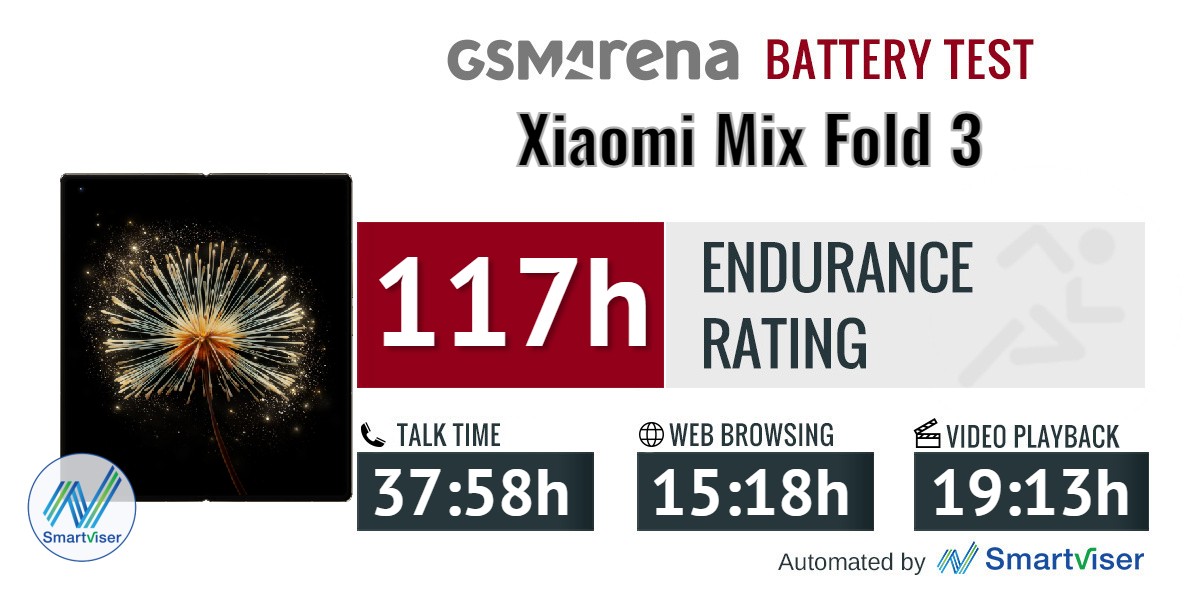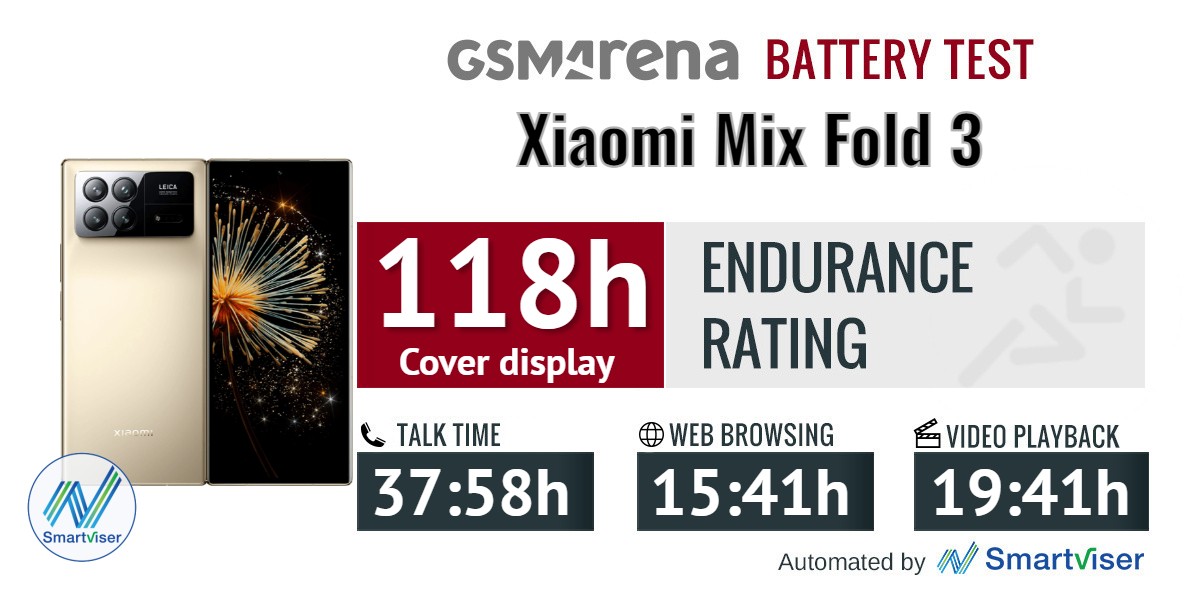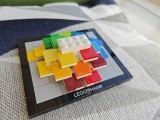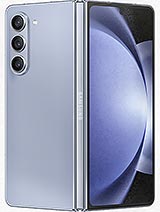Introduction
Three generations in, the ugly duckling has not only grown up to be a beautiful swan, but has also reached maturity. The Mix Fold 3 is Xiaomi's latest attempt at a phone-turns-tablet style of foldable and we're really liking it.

Xiaomi has managed to make several improvements over the previous model, which itself was a giant leap for the franchise. This year, we're getting more cameras (can there ever be too many?), bigger battery (always a good thing), yet nicer displays (not that the old ones were bad), wireless charging (about time), and the usual chipset upgrade. What we're not getting this time around either, is global availability. Sigh.
We do have one of the China-only Mix Fold 3s at the office for review and that's still something. We'll be taking a close look at the camera performance, where we're particularly excited about the new telephotos - a 3.2x and a 5x module means a lot more versatility than the lone 2x-ish zoom camera of the old model. And that, possibly, makes the Mix the most complete camera system on a large-size foldable on the market.
Xiaomi also promises a ton of brightness from the new displays while maintaining the size and proportions, which we quite liked already. Add to those improved panels the more efficient Snapdragon 8 Gen 2 and the battery capacity increase to 4,800mAh and we may be looking at a new foldable endurance champ.

The addition of wireless charging will contribute to a shorter cons list in the end, though one entry is already guaranteed to make it there - there's no waterproofing on the Mix Fold 3. Now that Google and Huawei have joined Samsung to offer that, we'd be less inclined to give others a pass.
But let's not get ahead of ourselves.
Xiaomi Mix Fold 3 specs at a glance:
- Body: 161.2x143.3x5.3mm, 255g; Glass front, glass/plastic back, aluminum frame.
- Display: 8.03" Foldable LTPO OLED+, 1B colors, 120Hz, HDR10+, Dolby Vision, 1916x2160px resolution, 10.15:9 aspect ratio, 360ppi; Cover display: 6.56" AMOLED, 120Hz, HDR10+, Dolby Vision, 1080 x 2520 pixels, 21:9 ratio, Corning Gorilla Glass Victus 2.
- Chipset: Qualcomm SM8550-AB Snapdragon 8 Gen 2 (4 nm): Octa-core (1x3.36 GHz Cortex-X3 & 2x2.8 GHz Cortex-A715 & 2x2.8 GHz Cortex-A710 & 3x2.0 GHz Cortex-A510); Adreno 740.
- Memory: 256GB 12GB RAM, 512GB 16GB RAM, 1TB 16GB RAM; UFS 4.0.
- OS/Software: Android 13, MIUI Fold 14.1.5.
- Rear camera: Wide (main): 50 MP, f/1.8, 23mm, 1/1.49", 1.0µm, PDAF, OIS; Telephoto: 10 MP, f/2.0, 75mm, PDAF, OIS, 3.2x optical zoom; Telephoto: 10 MP, f/2.9, 115mm, PDAF, OIS, 5x optical zoom; Ultra wide angle: 12 MP, f/2.2, 15mm, 120˚.
- Front camera: Wide (main): 20 MP, f/2.3, 23mm; Wide (main): 20 MP, f/2.3, 23mm; Wide (main): 20 MP, f/2.3, 23mm.
- Video capture: Rear camera: 8K@24fps, 4K@24/30/60fps, 1080p@30/60/120/240/960/1920fps, Dolby Vision HDR; Front camera: 1080p@30/60fps.
- Battery: 4800mAh; 67W wired, PD3.0, QC4, 100% in 40 min (advertised), 50W wireless, 100% in 55 min (advertised).
- Connectivity: 5G; Dual SIM; Wi-Fi 7; BT 5.3; NFC; Infrared port.
- Misc: Fingerprint reader (side-mounted); stereo speakers.
Xiaomi Mix Fold 3 unboxing
Xiaomi likes to make you feel special with the in-box contents of its higher-end phones and the Mix Fold 3 is no different. While the box has shrunk a bit, it still contains more than the bare minimum.

For example, you get a two-piece protective... solution for the handset. It consists of a back cover that snaps on the screenless end of the Mix (and can be further secured with adhesive strips) and doubles as a kickstand, and more of a frame that surrounds the cover display (also attached with adhesive strips).
A charger (67W one in this case) and a cable to go with it are still accessories you get with your Xiaomi, unlike certain competitors.
Design, build quality, handling
When the Xiaomi Mix Fold 2 came out, it was such a massive step up over the previous generation in terms of design and overall concept that it made the previous model look several years old immediately. The Mix Fold 2 was also among the thinnest foldables of its kind last year and a truly remarkable device to hold and marvel at. Little has changed now with the Mix Fold 3.
 Xiaomi Mix Fold 2 (left) next to Mix fold 3
Xiaomi Mix Fold 2 (left) next to Mix fold 3
The Mix Fold 3 maintains the same general proportions as last year's model and brings a 6.56-inch display on the cover, offering a 'regular-sized' smartphone feel in the folded state, so to speak. That's in contrast to the most popular phone-turns-tablet device out there, the Galaxy Z Fold5, the use of which in its folded state isn't exactly a pleasant experience.

There are, after all, some styling changes. For example, while the Mix Fold 2 only came with a frosted glass back in either of its two colorways, the third generation spices things up a couple of notches. Three colorways are available and our review unit is what we'd call the most basic, black variant.
It features a glass back panel that's matte and sort of textured like leather. It isn't soft and supple and grippy like the best implementations of 'vegan' leather that we've handled, but those are essentially plastic, and this one is glass - we pocket-knife-scratch-tested it, just to make sure.

The other black option has a composite back that has the weave of carbon fiber, but is made of 5 layers of ceramic and aramid fibers. Xiaomi says it's 36 times stronger than glass and 28% lighter. Thus equipped, the Mix Fold 3 weighs 255g, while the glass variants are a full 4g heavier. Speaking of, the other glass option is Gold.

The camera island has gotten larger, but it does have one extra module to accommodate, compared to the Mix Fold 2. Xiaomi has also adopted a version of the fine slope that the 13 Ultra has leading up to the camera bump. The camera island's mirror-like plate is ceramic. We'd say the whole look is very stylishly understated, even on gold variant where it does add a bit of contrast.

The styling change of more practical significance than the back panel, perhaps, is the new shape of the aluminum side rails. Now flat and matte, they're noticeably easier to grasp and make unfolding the Mix Fold 3 a more straightforward endeavor.
 Xiaomi Mix Fold 3 on top of Mix fold 2
Xiaomi Mix Fold 3 on top of Mix fold 2
And while unfolding the handset, you'll easily notice it's nowhere as eager to snap between phone and tablet states as the Mix Fold 2 was. Indeed, Xiaomi has redesigned the hinge for this generation in such a way that it can remain stable at angles between 45 and 135 degrees.

The Mix Fold 2 didn't give us grounds for complaint when it came to its crease, and the one on the Mix Fold 3 is similarly subtle - perhaps even marginally smoother still? We're not saying it's entirely flat, of course, and if you go looking or feeling for it, you'll notice it. But it's better than the one on the GAlaxy Z Fold5, for certain.

Xiaomi's press materials mention a TÜV certification for 500,000 hinge folds and that's probably the highest number we've seen of this kind, though we're not entirely sure that necessarily covers the display panel itself. Xiaomi's internal testing has shown that 200,000 folds later, the crease depth increases by just 10µm, so perhaps they do rate the whole assembly at 500,000.

Unfolded, the now-tablet feels great in the hand. The ultra-slim profile makes a distinctly premium impression while the device is also light enough to be comfortable to hold for extended periods of time.

The hardware bits are laid out in a familiar way on the Mix Fold 3, though we did spot a minor, inconsequential rearrangement - one of the secondary mics has been relocated. It's that pin hole in the frame that's now farther from the infra-red blaster. The SIM slot (dual nano) is on the other half of the phone, together with the top speaker, that also doubles as an earpiece.
Despite the orange gasket you can see there on the SIM tray, the Mix Fold 3 does not have an official rating for water resistance. Before the Pixel Fold and the Huawei Mate X3 it was only Samsung foldables that had an IPX8 rating and its lack in other devices was easier to look past. But now that more and more bendy smartphones offer that level of protection, the fact that it's missing on the Mix is more of a punishable offence.
Back to the tour of the periphery, we're seeing the USB-C port on the bottom, joined by what is the primary mic (there's a third one peeking out from the side of one of the rear cameras). The bottom speaker is here as well, naturally.
The power and volume buttons are on the right of the Mix Fold 3, and both are in the 'rear' half when the device is folded - unlike, for example, Honor that likes to keep them on opposite halves for one reason or another. Both click nicely.
The Mix Fold 3's power button also houses a capacitive fingerprint reader. It's easily accessible with either the right thumb or the left index finger and has worked trouble-free for us.


Bottom of the handset • Buttons on the side
A selfie camera punctures the cover screen in the middle of its top edge. The bigger news is that there is now a selfie camera on the inside as well - the Mix Fold 2 didn't have the internal one.
And since we're looking from up close, you can also see the somewhat wide lip of the bezel covering the flexible panel. The one on the Galaxy Z Fold5 is thinner, but sticks up a tiny bit higher. Neither is an issue, though.


Cover selfie camera and earpiece • Inner selfie camera
Overall, we'd say that the design and in-hand feel of the Mix Fold 3 are about as premium as you can get from a foldable in 2023. Even the latest Galaxy Z Fold5 with its (long-overdue) gapless folding doesn't quite have the same upmarket aura as the Mix. Now, if only the Xiaomi had water resistance.

Top-tier foldable display, the outer one is nice too
The Mix Fold 3 comes with some properly impressive display hardware. Both panels are Samsung-made E6 OLEDs with advertised peak brightness of 2600nits, Dolby Vision support and up to 120Hz refresh rate.

The internal display has an 8.025-inch diagonal and a resolution of 2,160x1,916px in a squarish 10.1:9 aspect ratio (pixel density works out to 360ppi). This panel is the Eco2 Plus variety and it doesn't have a polarizing layer, which improves light transmittance and, in turn, power efficiency. It's also an LTPO panel that enables continuously adaptive refresh rate in the 1 to 120Hz range.
In our testing, the Mix Fold 3's internal panel was good for 1277nits of maximum brightness with the auto brightness toggle enabled and the device placed under bright light. Not quite the 2,600nits of peak brightness from the promo materials, but it's not like we expected that with our standardized 75% patch of white. By all accounts, it's looking like the same panel as the one on the vivo X Fold2 - the diagonal and brightness numbers point in that direction.
When adjusting brightness manually, we got a little under half that - 593nits, and that's more or less the ballpark of what we'd call standard. Samsung has started enabling a manual boost up to around 800nits in recent years, and the Z Fold5 manages 741nits when you're operating the slider yourself, but the Xiaomi is easily good enough.
The cover display isn't quite as fancy - it's not an LTPO panel and its refresh rate is only modestly adaptive. At 6.56 inches in diagonal and with a fairly standard 21:9 aspect ratio it offers a vastly more comfortable smartphone experience than the Galaxy Z Fold5's outer screen. The resolution here is 2,520x1,080px for a pixel density of 418ppi.

On this panel we measured 1165nits of maximum brightness, about 100nits short of the vivo and the Honor, but right on par with the Galaxy. In manual mode, the Xiaomi was good for 550nits.
Color accuracy
The Mix Fold 3's display color handling is the same as what we saw on the 13 Ultra, which is sort of like it is on global Xiaomi's but not entirely. The default mode is Original color PRO and you also get Vivid and Saturated options, as well as three extra ones under the Advanced settings submenu.
In Original color PRO mode we got okay results for accuracy for our set of sRGB test swatches on both displays - with the usual bluish whites and grays, of course. It's the Warm temperature preset that fixes that shift, and gives you virtually perfect sRGB rendition - we measured an average dE2000 of 0.7 on both panels.

Vivid mode (targeting DCI-P3) was similarly a little off in its default state on both display. The Warm temp helped a lot on the internal display and improved the white and grays, making for an average dE2000 of 2.0. The Warm treatment wasn't quite as helpful on the cover panel where the average deviation was 2.9 and the white and grays remained shifted some 5 units towards blue.
There are specific sRGB and P3 modes in the Advanced settings menu, but as we've experienced before, those didn't get us accurate readings for the respective color swatches on the Mix Fold 3. Maybe we're doing something wrong.
HDR and streaming
The Dolby Vision support that the Mix Fold 3 offers isn't all too common but most welcome (it's mostly high-end Xiaomis that have it). Netflix didn't serve us HDR content, which is normal since the streaming platform doesn't usually play well with phones that are China-only releases. It did happily stream at FullHD resolution, thanks to the Widevine L1 certification. YouTube, on the other hand, did play HDR videos just fine.
Refresh rate
Both displays support up to 120Hz refresh rate, and there are two refresh modes in settings - Custom (where you can choose between 120Hz or 60Hz ceilings), and Default (automatic switching behavior).

The adaptive behavior works differently on the two panels with the internal one being truly adaptive and cover panel only partially so. The foldable screen drops down to 1Hz when the it's showing static content and can be incredibly dynamic (constantly changing between 10Hz and 120Hz with no apparent fixed steps) in games or browsers. The few scenarios where we saw it go for fixed refresh rates, besides 1Hz for static picture, were 24Hz for 24fps videos, 30Hz for 30fps clips, and 60Hz for HFR clips and apps that are incompatible with dynamic refresh rate adjustments. You can expect more or less the same thing whether you're in Default or Custom 120Hz mode, and the dynamic adjustments works the same way in Custom 60Hz, only capped at 60Hz.
The cover screen, on the other hand, supports fixed refresh rates and not a super wide selection of them - 30Hz, 60Hz, 90Hz, and 120Hz. If you've set Default or 120Hz, then you'll get 120Hz when interacting with the phone, with a drop to 60Hz for idling or video playback, and 30Hz for the always-on display.
Xiaomi Mix Fold 3 battery life
The Mix Fold 3 gets a minor battery capacity increase, its two cells now totaling 4,800mAh as opposed to the older model's 4,500mAh. The vivo X Fold2 and the Huawei Mate X3 match the new Mix, while the Honor Magic Vs (and now the V2) goes for a 5,000mAh capacity. The Galaxy Z Fold5 is more modest, making do with just 4,400mAh worth of juice.
In our testing, the Mix Fold 3 proved rather frugal and a significant (and most welcome) upgrade over the previous generation. We clocked over 15 hours of Wi-Fi web browsing on the large internal display, more than 50% better than the Mix Fold 2's result. The video playback figure has nearly doubled and now stands at 19:13h. The voice call longevity is a respectable 38h, another solid improvement, if not quite as dramatic. Add to that the very reasonable standby battery draw, and we're getting a class-leading overall Endurance rating of 117h.

Comparisons against rivals reveal that the vivo just might be able to squeeze a few extra minutes in web browsing, and the Galaxy just about matches the Mix in voice calls, but the Xiaomi is the true marathon runner of the foldable bunch.
Video test carried out in 60Hz refresh rate mode. Web browsing test done at the display's highest refresh rate whenever possible. Refer to the respective reviews for specifics. To adjust the endurance rating formula to match your own usage - check out our all-time battery test results chart.
We repeated the web browsing and video playback tests on the cover screen and only got marginally better results - across two separate sets of tests. The best way we can explain the minimal difference is with the foldable panel's superior adaptive refresh rate behavior which tends to maintain lower values in both instances than the cover's 60Hz threshold for both of our tests. Either way, the Mix Fold 3 has battery life to spare.

Our battery tests were automated thanks to SmartViser, using its viSerDevice app. The endurance rating denotes how long the battery charge will last you if you use the device for an hour of telephony, web browsing, and video playback daily. More details can be found here.
Charging speed
The Mix Fold 3 ships with a 67W charger, same as the one on the Mix Fold 2 and a bunch of other Xiaomis. Xiaomi says the phone should charge from 1% to 100% in 40 minutes, and that was also their claim on the Mix Fold 2, which had a slightly smaller battery. We couldn't quite match their lab results in our lab back then (45 minutes in our testing), and we couldn't on the Mix Fold 3 either.

We clocked a full charge from empty on the Mix Fold 3 at 50 minutes - not the speediest of foldables, but certainly better than the Galaxy Z Fold5, at least. Thirty minutes into the process we were looking at 70% in the battery indicator - decent, but hardly impressive.
Somewhat of a major development this year is the addition of wireless charging to the large Xiaomi foldable. The company advertises a 50W maximum charging rate when doing it wirelessly and their numbers say that a full charge should take 55 minutes. However, we were not able to test that, though we're still mostly of the opinion that speed isn't of the utmost importance for wireless charging - it's enough that there is wireless charging. There also is reverse wireless charging too.
Speaker test
The Mix Fold 3 has a stereo speaker setup with one unit on the bottom and one up top, and both of them in the 'left' half when the device is unfolded - or both are in the cover, so to speak. The channel assignment is as usual - the top one gets the left channel in portrait and in landscape the channels are switched to correspond to the phone's orientation. The opposite speaker always plays some of the other channel's sound too, albeit at a much lower volume.



Bottom speaker • Top speaker • Earpiece
The Mix Fold 3 earned a 'Very Good' rating for loudness in our test (just barely), which puts it a notch above the old model (just barely). That's also the same rating as the Galaxy Z Fold5, itself only squeezing into 'Very Good' by a very thin margin, with the rest of the large foldable on the other side of the divide and into 'Good'. Either way, they're all basically equally loud, theoretically, except the Oppo Find N2, which is somewhat quieter.
Mind you, the fact that the top speaker is also used as an earpiece and as such directs some of the sound forward, means that the handset may sound lounder in the closed state than in tablet mode in which the earpiece is facing away. While in reality that may not make a significant difference, our testing equipment did pick it up and we recorded a -28.1LUFS value in tablet mode.
In any case, we do have give the nod to the Mix Fold 3 for sound quality in this group. It's got the most balanced output, with solid low-frequency presence, clean vocals, and lively treble.
Use the Playback controls to listen to the phone sample recordings (best use headphones). We measure the average loudness of the speakers in LUFS. A lower absolute value means a louder sound. A look at the frequency response chart will tell you how far off the ideal "0db" flat line is the reproduction of the bass, treble, and mid frequencies. You can add more phones to compare how they differ. The scores and ratings are not comparable with our older loudspeaker test. Learn more about how we test here.
Android 13 with MIUI Fold 14.1.5
The Mix Fold 3 is running MIUI Fold 14.1.5, a foldable-specific version of Xiaomi's overlay, on top of an Android 13 core. The device is a China-only release, so it's on the Chinese branch of MIUI and we're not expecting an official global ROM.

That doesn't mean you don't get to use Google apps, it just means that you'll need to install them yourself, while the Play Services do come pre-installed. Also pre-installed is a wide array of Chinese apps, most of which you can thankfully uninstall.
Either way, you start off with the in-house browser and the default keyboard with the usual Chinese input capabilities and all of that is difficult to operate from a Western user's standpoint. Once you get Gboard, Chrome and the Play Store up and running, things get a lot smoother.
Still, there will be remains of Chinese elements here or there in the UI or in the system apps. Plus, we can't be certain if one or another software peculiarity wouldn't become an issue in the long run for more niche use cases.

Then there's the fact that some things in the UI and feature set are just different and that we find odd. For example, in some system apps (like the Clock) where the global MIUI builds use icons for different tabs, the Chinese build has simple text labels. The File Manager has that difference too, plus a different look of the Recent tab.
Next up, Xiaomi's own take on the Privacy Dashboard. Google released this privacy hub with Android 12, and different makers have been implementing it in their own ways, and Xiaomi itself has done it in two different ways depending on localization. Here the permissions are designated with icons, as opposed to the text labels in the global MIUI builds. Still, you get essentially the same functionality for keeping track of what app has used what permission when - it's just organized in a different way.






Clock • File Manager • File Manager • Privacy
It doesn't end there, naturally. We found no way to revert to a classic notification shade with quick toggles as the norm on most Androids - the Mix Fold 3 only has the two-pane option with notifications on the left and Control center on the right. Similarly, you don't get to choose the UI of the Recent apps - it's just the MIUI standard two-cards-per-row interface.



Notifications • Control Center • Recent apps
The homescreens would be familiar to a global Xiaomi user as well. You can choose whether to have an app drawer or not - that option has not been taken away. The leftmost pane is reserved for widgets only - it's not the Google Discover.






Lockscreen • Homescreen • Homescreen • App drawer • Widget pane • Settings
You unlock the screen via the side-mounted fingerprint scanner. It's always-on, fast and reliable, no complaints there. It can be set to trigger either on Press or on Touch. The latter may yield misreads due to its position, and that's why Xiaomi has set its default operation to be on Press.
Aside from the fingerprint reader, you can unlock the phone using 2D Face Unlock, but it is far less secure than the fingerprint option.






Biometric security • Fingerprint settings • Face unlock
MIUI comes with its proprietary multimedia apps - there's Gallery, and Music and Mi Video. And, of course, a Mi Remote app that uses the integrated IR blaster.
Then there's the Security app. It can scan your phone for malware, manage your blacklist, manage or restrict your data usage, configure battery behavior, and free up some RAM. It can also manage the permissions of your installed apps, define the battery behavior of selected apps, and apply restrictions only to certain apps.






Gallery • Music • Video • Mi Remote • Security
We'll reiterate that the division in design and functionality between Chinese and global MIUI builds perplexes us, but there could be some regional and cultural nuances that Xiaomi gets, and we don't. Just like the previous generation, you could seemingly use the Mix Fold 3 just fine outside of China, though you'll never be able to completely remove all references to Chinese apps and services, and some specific things may not work at all.
On to the main act, the Mix Fold 3's internal display and its 'tablet' mode implementation.
As before, the screen always shows two homescreen panes instead of just one. And the leftmost widget page from the default UI now pops up on top of the default homescreen. The larger display allows for a larger dock, which in addition to the up to six docked apps, also shows the three most recent ones.



Homescreens • Homescreens • Widget pane
The Notification shade gets pulled down from the left half of the status bar area, but drops down at the center of the display. The Control center, on the other hand, always takes the right part of the screen.


Notification center • Control Center
Some apps, like Settings, Notes, File Manager, make use of the larger screen by offering split-screen UI.



Settings • Notes • File Manager
There is a special 'Features for foldable devices' menu, which explains the things you can do on the foldable screen.
Floating windows and conversation bubbles is the first category. Floating Windows work in a familiar fashion - there is a Sidebar where you choose from a list of customizable apps. Once you tap on the app icon, it will launch within a floating window with full functionality.
Conversation bubbles from supported apps like Messages, Mail, and social networks are supported, too.
You can work with the floating app and move it around. You can also open it in full-screen, snap it on the left/right side to open split-screen view, or simply close it by swiping up on its bottom bar.
You can have up to two floating windows at the same time, and one or two apps in full-screen/split-screen mode opened in the background - this makes a total of four active apps on the screen.
The split-screen view is neat, but rather basic - you cannot change its size and it's always 50/50 with the border where the foldable display's crease is. A double tap on the border will switch the apps, but that's about all the customizeability you get.

The 'After folding' menu item deals with what the phone should do when you fold it in and gives you three options - conditionally continue the app on the cover screen if you swipe up within 6 seconds, continue the app without the need to swipe, or simply lock the phone when you fold it.
There's a section of the menu that lets you decide on a per-app basis how the app should treat the squarish screen - apps that have a nice split-screen interface work well in 'Parallel Windows mode, while older apps that run into trouble when faced with unusual aspects can get a forced 16:9, for example.
And finally, the last tab just explains how the default Baidu IME for MIUI keyboard is designed for this foldable device - with split-screen ergonomic UI, resizable, and with duplicate G and V letters for convenience. The duplicate G and V work with GBoard too, but only in landscape orientation, for some reason.
The hinge's ability to maintain arbitrary angles (hovering, Xiaomi calls it) allows the UI of some apps to switch to a foldable-only layout with the top half reserved for consumption and the bottom one for interaction. We found it to work with YouTube and the in-house video app. Netflix, for example, isn't optimized for it, but it does detect the folding and moves its entire interface into the 'hovering' half.
Some more foldable-related features show up when using the camera, but we'll talk about them later on in the review.
And that's about it. Overall, MIUI Fold doesn't strike us as particularly great at making use of the large screen - the split-screen functionality, for one, is rather limited. One UI does it better, we reckon.
Performance and benchmarks
Much like most of the large foldables this year (and most high-end smartphones altogether) the Mix Fold 3 is powered by the Snapdragon 8 Gen 2. Its octa-core processor features one prime core, four performance ones (further subdivided into 2+2), and three cores for less demanding applications, so it's a 1+2+2+3 setup. The Mix gets the higher clocked version of the prime core too - 1x3.36GHz Cortex-X3 + 2x2.8 GHz Cortex-A715 & 2x2.8GHz Cortex-A710 & 3x2.0GHz Cortex-A510 CPU cores.

The Gen 2 chipset offers 35% higher performance and 40% improved efficiency in the CPU department over the previous Gen and 25% and 45% performance and efficiency bumps on the GPU side of things (which goes by Adreno 740). It also has support for new, faster memory technologies (LPDDR5X and UFS 4.0). That's nice and all, but since you're likely comparing the latest phones to their equally latest rivals, those differences aren't all that important since most current top-tier devices have the same chip inside.
Just like the 13 Ultra, the Mix Fold 3 exists in three memory configurations - 12GB/256GB, 16GB/512GB (our review unit), and 16GB/1TB.
Our benchmark exploration starts with GeekBench as usual, where the Mix Fold is roughly on par with other SD 8 Gen 2 devices - no surprises here.
It's a similar story in Antutu as well, though the vivo is a bit of an overachiever here.
The Mix earns the 'overachiever' badge in the offscreen tests in GFXBench, where it tops the charts, even with somewhat of a significant margin in the less demanding titles.
The Xiaomi foldable continues to outperform the pack in the onscreen tests on the large display as well, most of the time posting figures about 10% higher than the Galaxy Z Fold5.
Running the onscreen tests on the cover display, the Mix Fold 3 inevitably surrenders the lead to the Galaxy Z Fold5 - the Samsung's lower resolution gives it an edge in frame rates.
In 3DMark's Wild Life test the Mix posted a higher-than-expected result, but things return to normal in Wild Life Extreme.
We also ran the usual stress tests on the Mix Fold 3 but we have no screenshots to show you, because the phone invariably overheated and shut down the apps. In the CPU throttling test that would happen around 20 minutes into it, while in the Wild Life Stress test in 3DMark it would last 11 to 13 loops.
We can try and gloss over those results with something along the lines of 'these are overly demanding synthetic tests that don't translate into real-life use' and that is true, but it's also true that other phones breeze through them, or at least complete them with some level of composure.
A versatile quad camera on the back
One of the key improvements on this year's Mix Fold is in the camera department - the large foldable now gets a proper quad-camera system with not one but two telephotos. The main camera remains the same upon a passing glance, but it isn't quite, and the ultrawide sees a bit of a downgrade - we can't have it all, apparently.

Starting off with the telephotos, there's one that offers a 75mm focal length equivalent (or a 3.2x zoom ratio) and another one that stands at 115mm (5x zoom). Both lenses are stabilized and the 5x is a periscope, and the apertures are f/2.0 and f/2.9 respectively. Each of these cameras uses a 10MP Samsung S5K3K1 sensor (1/3.94", 1.0µm.), same as on the Galaxy S23s.
The main camera is officially listed at 50MP, but Xiaomi also states it's using the Sony IMX800 sensor, which is nominally a 54MP unit with an somewhat unusual 1.43:1 aspect and a resolution of 8,768x6144px. Xiaomi is cropping a 8,192x6,144px portion from it, however, so both claims are technically correct. Of course, it's a Quad Bayer design, so the phone bins pixels 4-to-1, resulting in 12.5MP images by default.
With 50-ish million 1.0µm pixels, the resulting sensor arrangement is equivalent to the old one, only the Mix Fold 3 arrives there in a different manner. Well, there's also the potential that this newer sensor is likely superior to the IMX766 of the old model.
This primary camera's lens has a 23mm equivalent focal length and an f/1.8 aperture. The lens is stabilized too.
The ultrawide camera is based on an OmniVision OV13B10 imager which should technically be a 13MP unit, but the Mix Fold 3 is capturing 12MP images with it and that's the number that's in the specsheet. The same sensor was used on the Mix Fold 2, but packaged with a different lens - a better one, we might say, because the old phone had autofocus on its ultrawide, and this one doesn't. Then again, the Mix Fold 2's ultrawide couldn't focus all that close anyway, but we'd argue that even a 30cm minimum focus distance and AF is better than fixed focus.

You get two identical 'selfie' cameras, one per display. The phone reports it's using the OmniVision OV20b sensor for them, and information on it is somewhat scarce. The phone does report a 23mm equivalent focal length and an f/2.25 aperture.
Camera app
The camera app on the Mix Fold 3 is a tweaked version of the one we saw on the Xiaomi 13 Ultra, with further subtle touches to accommodate the foldable form factor. Naturally, basic operation like switching modes and changing zoom level is straightforward.
When in 'phone' state, the viewfinder has a couple of toggles on the far end, one for the Leica mode (Vibrant or Authentic), and one for the flash mode. Around here is sort of a status bar, where indicators for other settings appear when you switch them on (for example, the Auto HDR) and tapping on those indicators deactivates the feature and remove the indicator.

If you want to enable the feature once again, you either pull down from anywhere in the viewfinder, or tap on the little arrow button to open up a contextual settings menu. That varies depending on which mode you're in - in Photo mode it includes things like aspect ratio, Timed burst (a.k.a. intervalometer - neat), tilt-shift and timer.
There's a full-featured Pro mode where you can adjust exposure settings (white balance, ISO, shutter speed, aperture, exposure compensation). Naturally, you can also use manual focus here. Several aids are available, including a live histogram, focus peaking, and zebras.
The 'tablet' UI moves things around and places the zoom selector on the opposite side, so you'll need one hand to operate the shutter and the other for zooming. It's probably a good idea to use both hands in the unfolded state anyway, so perhaps that's Xiaomi's way of ensuring you do that.

There are two buttons in the top left corner. One of them enables the cover screen preview for your subject to look at themselves. The other engages a split-screen mode of sorts where the viewfinder takes up the right half, while the left turns into a filmstrip with the last captured images. If you're holding the device in 'portrait' orientation and you bend it just a little from the fully unfolded state, you get this split-screen view automatically.


Camera UI, tablet mode, vertical orientation
If you're in 'landscape' orientation and bend the handset into an intermediate position, it switches to a different type of split screen view, where the viewfinder can be in either half, depending on shooting scenario - waist-level or overhead shooting, for example.


Camera UI, tablet mode, horizontal orientation
Daylight photo quality
We proceeded to shoot most of our samples in the Leica Vibrant mode with the AI toggle switched off - this is the default state of the options and the way Xiaomi intended for most people to take their photos. We also have a handful of shots captured in the Leica Authentic mode lower down.
Mind you, while the Leica Vibrant mode is indeed the one that will get you the more expressive and more universally pleasing results, it's by no means overly colorful or saturated beyond reason. Quite the contrary - the photos have what we'd call just the right amount of pop, both in terms of saturation and contrast. The auto white balance has been treating us well and dynamic range is hard to fault either.
These overall excellent images pack great detail and the way it's rendered is also very mature so random textures look nicely natural. There's the finest of grain in areas of flat color, but only if you deliberately go looking for it.















Daylight samples, main camera (1x)
The differences brought by Authentic mode are quite subtle and not nearly as objectionable as we've seen on some other Leica-enhanced Xiaomi Ultras. For example, there isn't the heavy vignetting and general gloominess we witnessed on the 13 Ultra. You only get slightly less lush greens and just barely different blues in the skies in outdoors scenes. Perhaps surprisingly, reds tend to be more intense in Leica Authentic mode too.
We're ending up in a situation where we complained the Authentic mode on the 13 Ultra was too aggressive in its 'authenticity', and now that it barely makes a difference on the Fold 3, we have to wonder what's the point of two modes in the first place. Never quite satisfied, are we?












Daylight samples, main camera (1x), Leica Authentic
The Mix Fold 3's 50MP mode doesn't give you a upscaled version of the regular photos, but we wouldn't say it offers a meaningful detail advantage either.












Daylight samples, main camera (1x), 50MP
The 2x zoom images from the main camera look more or less identical to the 50MP ones on a pixel level from a detail standpoint - not great, but decent, particularly if you're dealing with more straight lines than random textures. Noise performance is noticeably better here than in the full-res mode, which is nice.








Daylight samples, main camera (2x zoom)
The Mix Fold 3's zooming prowess extends way beyond the 2x capability of its main camera, though, and both the 3.2x and 5x modules deliver excellent results. Images are sharp on both while noise is minimal on the 3.2x module and a bit more pronounced but not too troublesome on the 5x one. Contrast is also quite nice on both modules.
Minor color variations can be spotted between the two telephotos, and between them and the main camera. We'd dismiss them as negligible and only really noticeable in side-by-side comparisons.








Daylight samples, telephoto camera (3.2x)








Daylight samples, telephoto camera (5x)
The ultrawide camera's output is very consistent with the main unit's in terms of color, with only a hint of extra saturation in this scene or that. The ultrawide shows rather impressive dynamic range and excellent contrast. Detail is also great. The one issue here is the fixed focus, which means nearby subjects will inevitably end up blurry.
Low-light photo quality
As is the norm, the Mix Fold 3 applies some form of Night mode processing when it deems necessary in Photo mode. The amount of difference that you'd be able to spot between shots taken in both modes varies by camera and scene. A general observation that applies to the Mix Fold 3's output at night is that it does relatively little shadow brightening, making for a truer, if not necessarily quite as pleasing rendition of reality, particularly in darker scenes.
Main camera
We found ourselves hard pressed to find differences between the main camera's photos in both modes, when shooting at 1x - other than the way neon signs and other bright colorful lights are rendered, and even then the differences aren't subtle.
As already mentioned, shadows are fairly dark and highlights in some scenes can be that extra bit more blown out than what we'd call ideal. Still, the Mix Fold 3's relatively contrasty and somewhat 'classic' photographic look isn't bad - it's just that we've gotten used to a more HDR-y rendition.
We can't really complain about color - the phone's auto white balance does an expert job, even in scenes with mixed light sources. Saturation is on point too.











Low-light samples, main camera (1x)
Detail is excellent either way - there's no water-color effect and things are nice and sharp. The lax noise reduction is doubtless partially responsible, but we'd certainly take a bit more grain when it means extra detail.











Low-light samples, main camera (1x), Night mode
There is no 2x zoom button in the Night mode viewfinder, but the phone does allow you to pinch your way to 2x. These being captured on the main camera that's already proven to be fairly consistent between modes, we're inclined to say that there's no point in the extra steps - just use Photo mode. If anything, the Night mode shots here are a tiny bit softer. To be fair, in both cases you won't be getting too much per-pixel sharpness anyway.






Low-light samples, main camera (2x zoom)






Low-light samples, main camera (2x zoom), Night mode
Telephoto cameras
The actual telephotos certainly deliver sharper, better detailed results - evident upon 1:1 examination. Distant facade details come close and are drawn very well, even if a little noisy. Colors are mostly accurate, with only occasional missteps in the white balance (compare the 5x result on that seventh scene to the 3.2x photo), and a hint of desaturation.








Low-light samples, telephoto camera (3.2x)








Low-light samples, telephoto camera (5x)
Switch to the dedicated Night mode, and on both the 3x and 5x cameras we're observing consistently softer images - the difference is small, but it's there. It's also worth keeping in mind that the sharpness penalty in Night mode comes with no observable benefits in the other properties of these images - you don't get better dynamic range or improved color reproduction. We'd stick to the full auto.








Low-light samples, telephoto camera (3.2x), Night mode








Low-light samples, telephoto camera (5x), Night mode
Ultrawide camera
Things are quite similar on the ultrawide, where Photo mode is delivering solid results. Exposures are good, white balance is dependable and saturation is well maintained in the dark. Shadows can be a little noisy, but still quite detailed and sharpness is very good overall. Night mode softens the noise into oblivion and we'd rather have the better detail of Photo mode.








Low-light samples, ultrawide camera (0.6x)








Low-light samples, ultrawide camera (0.6x), Night mode
Once you're done with the real world samples, head over to our Photo compare tool to see how the Xiaomi Mix Fold 3 stacks up against the competition.


Xiaomi Mix Fold 3 against the Galaxy Z Fold5 and the vivo X Fold2 in our Photo compare tool
Portraits
The Mix Fold 3's portrait mode defaults to the 3.2x zoom camera and there's no apparent zoom selector, though the quick settings menu reveals a 'Full body' mode that switches to the main camera - a bit counterintuitive, but you do ultimately get both options.
The default 3.2x zoom level offers you a very comfortable shooting distance and a perspective that's flattering to facial features. Per-pixel quality on the subject is pretty good too, even in relatively dim indoor conditions, so you're not sacrificing image quality to get the perspective. The default blur level is a bit excessive though, and the subject detection, while mostly good, can sometimes struggle.
The Full body mode appears to be doing a better job with subject detection, but its background blur effect is also a touch too strong. Image quality is better here, after all.




Portrait mode samples, Full body mode, 1x
Selfies
There are a whole bunch of ways you can take selfies on the Mix Fold 3, and we'd argue the best one is with the main camera and the device unfolded. You'd be getting crisp detail, pleasing skin tones (and great color overall, of course), and wide dynamic range. Plus some natural background blur to make the subject (yourself, obviously) stand out.
Then there's the ultrawide. While admittedly lacking autofocus, its focus distance is such that your face will be just about acceptably sharp when shooting at arm's length - particularly if stretch your arm a bit. That will let you get more people in the frame, or add context. However, if you want distorted perspective close-ups - tough luck, you'll be blurry.




Selfie samples, ultrawide camera
For both of the above sets of samples we used the palm shutter release method, because the Mix Fold 3 can be unwieldy to handle in tablet mode and we'd rather not drop it. A Bluetooth ckicker can also be used.
There's also the option to lean the phone against a wall and use the telephoto cameras with the cover screen acting as a viewfinder - to record TikTok dances from afar, or whatever it is youngsters are doing these days.
If you can't be bothered to open the Fold, you can also use the cover screen's selfie camera. As best as we can tell, these are upscaled from the 4-to-1 binned 5MP output of the sensor and aren't pin-sharp. They can't quite match the main camera for dynamic range either, but it's not half bad and you'd still be getting nice colors, too.
The internal camera should capture the same images, only with a larger viewfinder and more cumbersome handling. That said, we're fairly convinced we're seeing an ever so slightly warmer and more saturated color rendition on this one. We could be wrong though.
Video recording
The Xiaomi Mix Fold 3 records video up to 8K24 with its main camera, where you also get 4K at 24, 30, and 60fps. The ultrawide maxes out at 4K30 (so no 4K60, and no 8K), but it too can do 4K24.
On the surface, 4K is available all the way up to 5x zoom, but don't be fooled - it's all coming from the main camera. So don't expect it to be looking nice at all at the far end of the zoom range - we'd refrain from going above 2x in 4K and even that may be a bit of a stretch. The actual telephoto cameras max out at 1080p resolution and the 3.2x unit can go up to 60fps, while the 5x module is capped at 30fps. It's quite the hodgepodge of limitations to keep in mind, indeed.
The main camera's 4K footage looks identical at 24fps and 30fps, with 60fps clips having an edge in sharpness - the lower frame rates aren't quite as crisp, if still okay. All the other aspects of image quality are the same between the three modes - white balance is dependable, color saturation makes things look pleasing without going to extremes, dynamic range is excellent.
The 8K clips have that usual upscaled watercolory artificial look of smartphone 8K with little benefit in terms of detail over 4K. Colors and dynamic range are the same as 4K, though, so there's that.
The main camera's 2x output is slightly less detailed on a per-pixel level than the 8K capture and is not super sharp, but it's still usable.
Once again, we wouldn't shoot in 4K at anything beyond 2x. The 3.2x camera's 1080p 30fps results are excellent, though. Detail is great as 1080p goes and it's rendered in a relatively natural way. Colors and dynamic range are on point too. The 60fps mode does bring notably more aggressive sharpening, which spoils the look a bit.
No such issues on the 5x telephoto - it simply doesn't support 1080p 60fps. The 1080p 30fps clips, on the other hand, are great.
The ultrawide's 4K30 is a bit more contrasty than ideal and its shadows can be too dark for our liking. The color saturation is also a touch higher than on the main camera. Detail is very good though, albeit it with some noise in there as well.
Stabilization is predictably excellent on the Mix Fold 3. Both the main camera and the ultrawide are great at compensating for walking shake and there are no weird wobbles or jelloing. Pans are generally smooth, though we did often encounter a somewhat sharp transition from panning to stillness. If you're just pointing the phone in one direction the footage is nearly tripod-grade steady.
The telephotos are similarly impressive in their stabilization, though we did observe the less than perfect panning here as well.
In low light, the main camera captures solid 4K30 clips. It exposes well and has good dynamic range, while also maintaining color saturation and fidelity.
The telephotos are nowhere as praiseworthy. The 3.2x unit returns rather soft clips, while the somewhat sharper 5x module suffers from severe astigmatism (those vertical streaks originating from point light sources).
The ultrawide's 4K30 footage at night isn't remotely remarkable either with the shadows being particularly soft and noisy.
Selfie videos from the Mix Fold 3's main camera are good to very good. Detail is alright, albeit not quite as sharp when examined from up close as we'd like. The stabilization isn't impeccable either - we got both some walking shake and slightly odd panning motion - though if you're mostly stationary, you should be perfectly fine. Dynamic range and color reproduction leave little to be desired, and the subject separation provided by the large sensor/close shooting distance combo is most welcome.
Ultrawide selfie videos will tend to leave your background sharper because of the fixed focus. While you could make a conscious effort and keep your arm stretched out as far as it can go for stills, maintaining that position for video capture isn't nearly as feasible. Colors are looking nice and dynamic range is okay, if not super wide.
Here's a glimpse of how the Xiaomi Mix Fold 3 compares to rivals in our Video compare tool. Head over there for the complete picture.


Xiaomi Mix Fold 3 against the Galaxy Z Fold5 and the vivo X Fold2 in our Video compare tool
Competition
The Mix Fold 3 once again places us in a weird situation we've been with a few previous Xiaomis and some other high-end foldables of having to theorize how it compares to potential rivals and imagine what it would be like if it was sold globally. We could do that, of course, it's just that we'd rather be faced with a more practical predicament.

The Galaxy Z Fold5, the most widely available and possibly the overall most sensible option for a large foldable, naturally comes to mind first. The Samsung will give you a much more productivity-focused feature set right out of the box, plus support for a stylus. It's also got the waterproofing that Xiaomi hasn't bothered to achieve. The Mix looks like the better cameraphone for stills, though the Galaxy likely wins for video capture. The Xiaomi's longer battery life and faster charging help reinforce its case too.
Also globally available, technically, but limited in its global appeal because of lack of Google services, the Huawei Mate X3 presents a viable alternative to the Mix Fold 3. It too has an IPX8 rating, like the Galaxy, and unlike the Mix. Charging speed is a toss-up, but battery life is better on the Xiaomi, and its displays are generally superior too. Once again, the Mix is likely the better photo camera, but the Mate is a more capable camcorder. The Mate runs on last year's chipset, though, which is a bummer.
The Honor Magic V2 addresses a few of those complaints - it matches the Mix Fold 3 in terms of chipset and has Google services. A truly global version is quite possibly on its way too, making it one better than the Xiaomi from our perspective. Not quite as good at zooming in, the Magic has a very intriguing camera system still, but we'll need to wait for a review unit to establish its capabilities. It's a similar thing with battery life and the rest of the measurable bits.
We did get to experience the vivo X Fold2 already, and we particularly liked it for a specific reason you'd probably not think of at first - its dual under-display fingerprint sensors set it apart from the side-mounted competitors. That's hardly enough to make it the go-to option all on its own, so it's good that the X Fold2 is capable in the other key areas - it's got essentially the same displays as the Mix, similar battery life in actual use (not as good at idling though), and faster charging. While similarly a China-only release, the vivo does have a less Chinese-looking software build so it could be a better option for gray-importing.




Samsung Galaxy Z Fold5 • Huawei Mate X3 • Honor Magic V2 • vivo X Fold2
Verdict
The Mix Fold 3 is another step in the right direction for the Xiaomi foldable lineup, if not quite as dramatic as the transition from the first to the second generation. That said, some things haven't been addressed yet, like the waterproofing, less than ideal thermals, lackluster video capabilities and software that's not as useful as it could be. The move from an autofocusing ultrawide to a fixed focus one also perplexes us.

However, this third generation does bring meaningful upgrades. We're fans of longer reach and we very much appreciate the 5x telephoto, and it's nice that there's a 3.2x unit to bridge the gap too - there haven't been such zoom-focused foldables lately. Tying nicely with the enhanced imaging setup is the new hinge design that adds another layer of usefulness to the form factor. Also improved are the displays, now with some extra nits and better efficiency, which leads nicely us to the Mix Fold 3's superb battery life.
We're absolutely happy that Xiaomi isn't making this one available globally. They'll probably further improve the Mix Fold next year, with 4K on the zoom cameras and an AF-ing ultrawide, and add waterproofing and only then make it go worldwide. This one can stay in China for all we care. Sour grapes, much?
Pros
- Rich retail bundle with a 67W charger and a premium case.
- Classy design, hinge can now remain open in intermediate positions.
- Thoroughly wonderful displays, Dolby Vision support too.
- Class-leading battery life, wireless charging is also on the table now.
- Excellent speakers.
- Great photo quality across all cameras (well, the rear ones, that is).
- IR blaster, still.
Cons
- China-exclusive release with a ton of Chinese apps pre-installed.
- No waterproofing.
- Somewhat limited software implementation for the large screen.
- Tendency to overheat under prolonged load, both CPU and GPU.
- No AF on the ultrawide camera.
- Some hiccups in video stabilization, no 4K video on the telephotos.
from GSMArena.com - Latest articles https://ift.tt/ED1FgcB
via IFTTT
Bagikan Berita Ini








































































0 Response to "Xiaomi Mix Fold 3 review"
Post a Comment